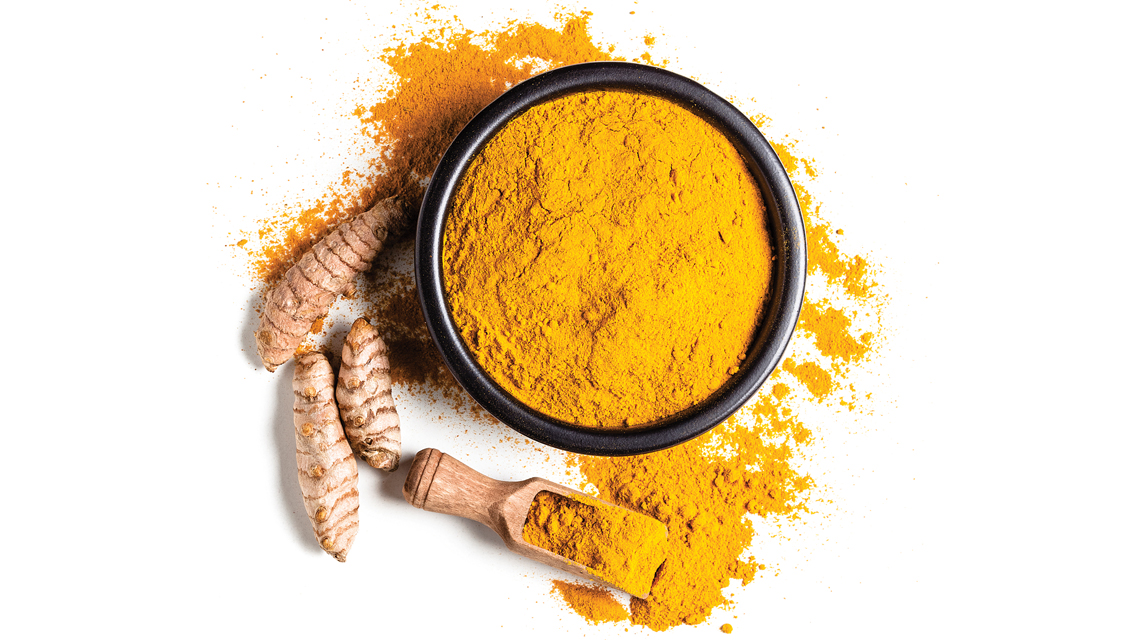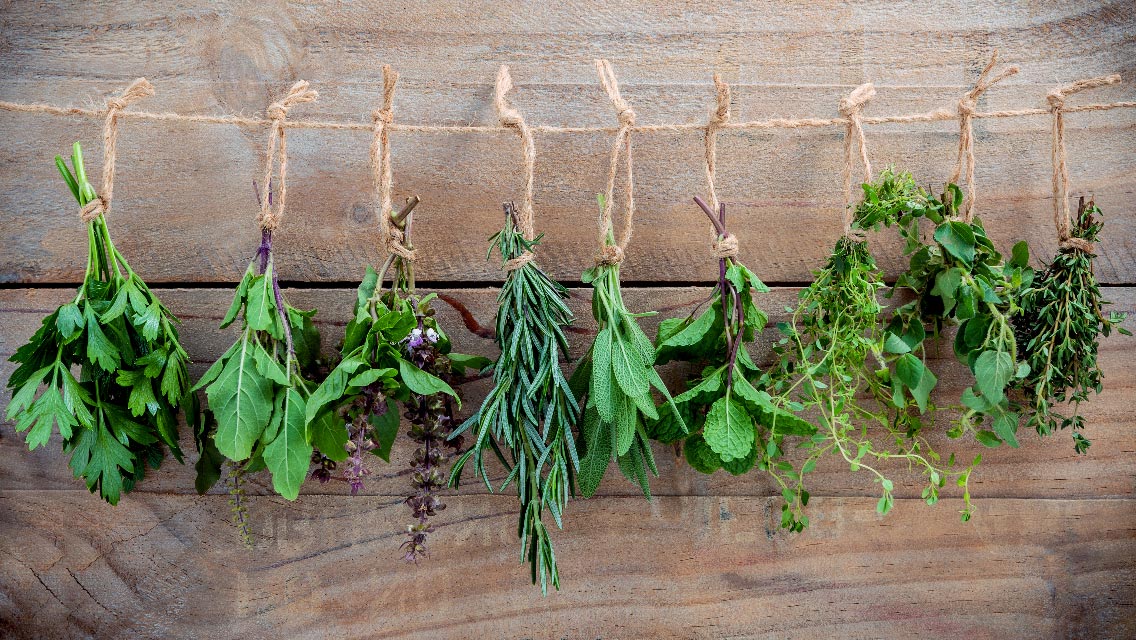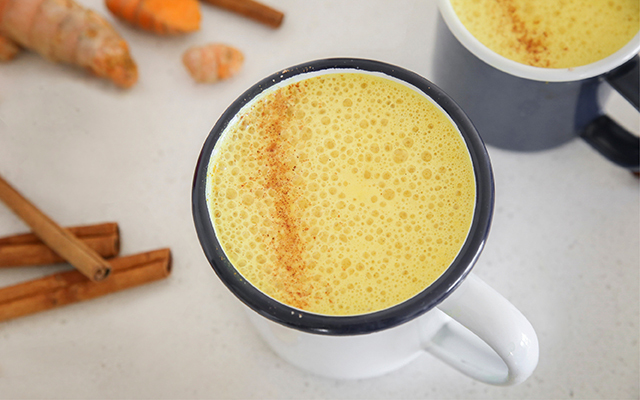Indian saffron. Haldi. Turmeric root. Curcuma longa. Holy powder. The golden spice.
Whatever name you know turmeric by, this gnarled member of the ginger family is most familiar as the spice that gives curry its distinctive yellow hue. And today it’s popping up everywhere: in lattes, juices, teas, sauces, and even skincare products.
Yet its celebrity status isn’t new. The twisty rhizome’s popularity is rooted in millennia of traditional wisdom as well as hard science. Turmeric has long been prized by Ayurvedic and Chinese medicine for its anti-inflammatory and antimicrobial properties. One of its most active compounds, curcumin, has been the subject of more than 15,000 scientific papers.
Turmeric’s reputation as a health-promoting powerhouse is well earned.
“It is multifunctional, and its uses span many dimensions of health and medicine,” says Ayurvedic practitioner Bhaswati Bhattacharya, MPH, MD, PhD.
Discover the variety of ways you can leverage this nutrient-dense spice to boost your health.
The Turmeric–Curcumin Connection
Turmeric contains hundreds of beneficial compounds, including fatty acids, fiber, minerals like iron and manganese, and sesquiterpenes (bioactive substances that can help reduce inflammation).
To date, scientists have largely focused on the rhizome’s curcuminoids, the polyphenol pigments responsible for its vibrant color. Of turmeric’s main three curcuminoids, curcumin seems to be the most potent active ingredient in turmeric. It’s the one that’s most frequently extracted and used medicinally, though studies suggest the others offer value as well.
“Curcumin has become a real workhorse as a prescription in the functional- and integrated-medicine world,” says functional-medicine practitioner Susan Blum, MD, MPH, author of Healing Arthritis: Your 3-Step Guide to Conquering Arthritis Naturally. Along with nutrition and lifestyle recommendations, she frequently prescribes curcumin capsules to patients with arthritis, leaky gut, and other inflammatory conditions.
“We use it a lot because it’s that good,” says Blum. “It’s really one of the most well-studied herbs out there — and one of the safest.”
“[Curcumin] is really one of the most well-studied herbs out there — and one of the safest.”
The challenge lies in consuming enough curcumin to see appreciable results: about 500 to 1,500 mg per day. Turmeric powder contains about 3 to 5 percent of the bright yellow phytochemical, so a tablespoon of turmeric yields only about 136 mg of curcumin. That means you’d need to eat at least 4 tablespoons of turmeric daily for a measurably therapeutic dose — something no practitioner is likely to recommend because of the risk of digestive upset.
Clinical trials also suggest that we may not readily absorb curcumin on its own, so supplements often contain lecithin or other oils, sometimes with black pepper or piperine, to enhance bioavailability. (Most turmeric supplements come in capsules or tablets, though there are liquid formulations available. Some experts believe liquid formulations are more easily absorbed, but there’s no evidence to support this.)
This synergistic combination is long understood. For thousands of years, Ayurvedic cooks and physicians have used ghee (clarified butter), black pepper, and pippali (Indian long pepper) to enhance turmeric’s bioavailability in food and medicines. For this reason, many physicians trained in Ayurveda recommend consuming turmeric by simply cooking with it.
“Swallowing a capsule prevents you from tasting the spice, and neuroscientific evidence indicates that the way you taste something changes the way you digest it,” says Bhattacharya, whose patients have shown measurably reduced inflammation in blood tests after regularly cooking with the spice mixtures she prescribes. “Cooking turmeric in fat is actually what makes it therapeutic.”
Traditional preparations call for heating the powdered spice in ghee, milk, or oil to activate its healing compounds.
You can also cook with fresh turmeric root, although this is not for everyone. Bhattacharya has found that it can be too “heating” for many people, especially those with stomach hyperacidity. Functional-medicine specialist Robert Rountree, MD, has not seen any studies that suggest fresh turmeric is too heating, but he does note that raw turmeric juice can trigger digestive distress.
Some people still prefer fresh turmeric root for its flavor, and because it naturally contains turmeric oils, the curcuminoids are more readily bioavailable. So whether or not to consume fresh turmeric may be a matter of digestive tolerance and personal taste.
Eating turmeric isn’t the only way to get its benefits, though. Bhattacharya also uses the powder topically to treat cuts, sprains, and acne because of its anti-inflammatory and antimicrobial effects.
Whether you consume your turmeric by cooking, by supplement, or both (as many integrative practitioners suggest), the spice offers a variety of benefits.
5 Turmeric Benefits
1. Arthritis Reliever
Research shows curcumin helps moderate the production of cytokines, or cellular proteins that regulate inflammatory responses. Taking curcumin supplements seems to relieve arthritis pain, which is largely inflammatory; the Arthritis Foundation lists curcumin among its resources for pain management.
In a 2010 clinical trial, osteoarthritis patients who took 200 mg of curcumin daily for eight months reported significant long-term improvement in knee pain. A small 2012 pilot study found that people with rheumatoid arthritis who took 500 mg of curcumin daily experienced less joint pain and swelling than people taking nonsteroidal anti-inflammatory drugs (NSAIDs), such as ibuprofen and aspirin.
“Curcumin’s anti-inflammatory effects are not just the result of blocking one individual enzyme, like nonsteroidal anti-inflammatory drugs, which inhibit the COX enzyme,” Rountree explains. “Curcumin seems to block multiple molecular targets — perhaps most importantly the nuclear factor kappa beta (NF-kB), the final common pathway for inflammation.”
1 to 2 teaspoons of turmeric powder or up to 3 grams of freshly ground turmeric root daily [is recommended] for general therapeutic benefits.
He recommends 1 to 2 teaspoons of turmeric powder or up to 3 grams of freshly ground turmeric root daily for general therapeutic benefits. Rountree also prescribes curcumin extract — “the big guns” — for arthritis and other inflammatory conditions.
Since straight curcumin is poorly absorbed, he prefers to use it combined with soy or sunflower lecithin, called curcumin phytosome. This formula “has significantly enhanced absorption and is the subject of over 30 published human clinical studies,” he says.
People generally tolerate curcumin well (though in very rare cases it can cause liver toxicity) and tend to notice improvement within a few days. “Curcumin is very safe to use long-term. It’s not like NSAIDs, where you should take a few doses and then immediately stop,” explains Rountree. (He does note that people with active gallbladder disease should avoid it: Curcuminoids stimulate bile flow in the liver, which can be hard on the gallbladder.)
Curcumin is also helpful for vegetarians and people who simply can’t take fish oil, another popular anti-inflammatory supplement, says Blum.
Its antioxidant and anti-inflammatory properties work hand in hand. “Inflammation and oxidative stress are two sides of the same coin,” she explains. “Oxidative stress leads to inflammation, and that’s what starts the damage to the joint capsule and surface. Putting that fire out is really critical; curcumin quiets all that brewing.”
Blum also emphasizes the importance of a whole-foods diet rich in vegetables and low in processed foods and sugar. “Curcumin has to be part of a food plan.”
Blum also emphasizes the importance of a whole-foods diet rich in vegetables and low in processed foods and sugar. “Curcumin has to be part of a food plan.”
Depending on the severity of your joint pain, you may benefit simply from adding more turmeric into your diet, says Ayurvedic expert Nancy Lonsdorf, MD, who educates physicians at the Scripps Center for Integrative Medicine. She cites a patient who saw notable improvements in her joint pain just from adding turmeric to her daily eggs. “I encourage people with inflammation to use turmeric in every meal.” (For more on healing arthritis naturally, see “The Healing Arthritis Protocol”.)
2. Supports the Gut
People on the Indian subcontinent have a much lower incidence of colon cancer than we do in the West, and researchers theorize that it might have to do with the generous quantities of turmeric they consume. The ghee in traditional curries also makes the curcumin bioavailable.
A 2015 clinical trial of ulcerative-colitis patients found that curcumin reduced their symptoms. Another study discovered that people with IBS showed reduced abdominal discomfort and improved bowel movements after taking one or two curcumin tablets daily for eight weeks. Lab studies suggest curcumin reduces inflammation in the intestines and strengthens gut-barrier function.
“Curcumin has a good local effect on the microbiome,” says Blum. “If you have an imbalance in the gut microbiome, you can end up with a leaky gut. The tight junctions get damaged, and bacteria and all sorts of other immune-triggering compounds seep out of the gut and into the body. The immune system gets very triggered — that’s a huge cause of inflammatory arthritis.”
For people who have gut issues but can tolerate dairy, Bhattacharya recommends golden milk, a traditional hot drink made with milk and turmeric; it’s also tasty with coconut or almond milk. (See “How to Eat More Turmeric,” below) Supplements may help, too.
3. Blood-Sugar Balancer
Curcumin may mitigate the insulin resistance and hyperglycemia that characterizes both type 1 and type 2 diabetes, according to a 2013 systematic review. “Curcumin helps improve the cells’ response to insulin, which helps lower the blood sugar,” explains Blum.
A notable study published in Diabetes Care shows that prediabetic patients who took curcumin capsules for nine months were less likely than patients taking a placebo to develop type 2 diabetes. A small randomized controlled study found that healthy people who took a 180 mg tablet of curcumin with meals had lower glycemic and insulin responses after eating.
Still, if you’re just living on cookies and ice cream, says Blum, “you can take all the curcumin you want and it’s not going to help you.” Dietary choices will always matter.
4. Brain Protector
People in some regions of India have notably low rates of Alzheimer’s disease, and researchers hypothesize that turmeric consumption may be a factor: These locals generally eat at least 2 teaspoons in their daily curries (a substantially lower amount than the 4 tablespoons some research has shown to be effective).
Studies show that curcumin can slow, and even stop, the formation of beta-amyloid plaque deposits in mouse brains. Animal studies on tumerone, another turmeric compound, indicate that the chemical may stimulate brain-cell growth, while a review published in the Journal of Alzheimer’s Disease suggests that curcumin may be more effective than other available treatments at curbing the cognitive decline involved in Alzheimer’s. Human studies are forthcoming.
“Turmeric helps the brain detoxify by binding heavy metals and helping them exit the brain and the body. It curbs inflammation.”
“There’s been a sea change in understanding Alzheimer’s disease, and it’s driven by the fact that drugs are not working,” says Lonsdorf, author of The Healthy Brain Solution for Women Over Forty. The reason for this shift is that the brain can be damaged through many different pathways, but any one drug will tackle only three or four pathways at most. Turmeric appears to affect many more.
“Turmeric helps the brain detoxify by binding heavy metals and helping them exit the brain and the body. It curbs inflammation,” she explains.
“Turmeric has also been shown to enhance the production of BDNF, brain-derived neurotrophic factor, which means it has a direct effect on the hormones that support healthy neurons and neuron growth.”
Lonsdorf notes that lab studies have also found that macrophages (immune cells that eat up amyloid plaque) treated with curcumin consume amyloid at a higher rate than controls.
You can’t, however, just sprinkle turmeric on your chili cheese dog and hope for the best. “We have to go to the root and address those things that are causing inflammation,” she says. Root causes include the usual suspects: sugar, poor diet, a leaky gut, lack of exercise, and prediabetes, which can cause brain cells to shrink.
5. Cancer Fighter
Cancer researchers have begun exploring curcumin’s anti-inflammatory potential for prevention and treatment.
“I would not use turmeric or curcuminoids by themselves to treat cancer,” says Rountree. “But there is some evidence that they could be combined with conventional treatments to enhance their efficacy or decrease side effects.”
A National Cancer Institute study found that curcumin reduced fatigue among breast-cancer patients undergoing radiotherapy. Another showed gargling water with turmeric effectively reduced radiation’s side effects in patients with head and neck cancers. Other research suggests curcumin may slow tumor growth in prostate-cancer patients.
The Future of Turmeric Research
Though curcumin has been included in numerous scientific papers, turmeric and curcumin have been the subject of only a handful of double-blind, placebo-controlled clinical trials, the gold standard in medical research.
Lonsdorf likens the ongoing research on turmeric to pulling a fabric apart and studying each strand. “We’re going piece by piece and saying, ‘Oh, this thread is important!’ But there are 200 other threads you’re going to discover, and Ayurveda already knows that they’re part of the whole fabric.”
Tips to Buy and Store Turmeric Powder
Not all turmeric powders are created equal. Much of what’s sold in grocery stores comes from roots that have been boiled then dried. (The potent leftover liquid is used for dyes and decoctions.) “Even though it’s been cured like this for processing, it’s still turmeric by FDA food-regulation standards, so people think they’re getting the whole turmeric, but they’re not,” says Ayurvedic doctor Bhaswati Bhattacharya, MPH, MD, PhD. Worse, some distributors may add talcum powder, color additives, and even lead.
Source your turmeric powder from a certified-organic, fair-trade company that practices stringent testing processes. Experts recommend you steer clear of bulk bins and internet sales; those spices are often old and can be compromised.
Store turmeric in an airtight glass container in a cool, dry place away from sunlight. Use within six months for optimal flavor and potency.
6 Tips to Eat More Turmeric
Consider these easy ways to get more turmeric in your diet.
- Golden Milk: Creamy and soothing, golden milk is a traditional Ayurvedic tonic. Heat 1 cup organic dairy or nondairy milk with 1 teaspoon turmeric powder, ½ teaspoon ghee, and a sprinkle of black pepper. Spice it up with a pinch of cinnamon and cardamom, and add honey or organic sugar to taste.
- Sauces and Soups: One of the easiest ways to incorporate turmeric is to add it to sauces, says Ayurvedic doctor Bhaswati Bhattacharya, MPH, MD, PhD. When sautéing turmeric in oil, “make sure you’re using an oil that sustains high temperatures and won’t turn into a trans fat.” Ghee, coconut oil, and mustard oil are all good choices, depending on the season.
- Curries: Curry dishes come in myriad flavors from India, Asia, and Africa. Traditional Indian recipes typically call for ghee, black pepper, and other spices that enhance turmeric’s bioavailability. These often also include ginger — another anti-inflammatory powerhouse. (You can find an array of curry and other turmeric recipes here.)
- Breakfast Dishes: Give your morning meal an anti-inflammatory boost by sprinkling a bit of turmeric powder into the pan when you’re scrambling your eggs or whipping up an omelet. It’s also tasty in oatmeal, with a little cinnamon.
- Stir-Fries: Add ½ to ¾ teaspoon of turmeric powder when sautéing vegetables. Too much? Start with ¼ teaspoon and work your way up. But take note: “If you put it in at the very end, it won’t cook and it will make the food bitter. If you put it in at the very beginning, it will burn,” Bhattacharya says. She recommends heating the oil, adding the vegetables and any whole spices, and then when you’re stirring and ready to add salt, add the turmeric as well.
- Other Uses: As long you’re heating turmeric in oil or liquid, you can add a bit to pretty much anything you cook, says Ayurvedic expert Nancy Lonsdorf. “It doesn’t usually alter the flavor to the point where you won’t enjoy it. If you put two teaspoons in your coffee, you might not like it. But if you put a quarter or a half teaspoon in, you won’t even notice it and it will have its benefit.”
This originally appeared as “Go for the Gold” in the January/February 2020 print issue of Experience Life.




This Post Has One Comment
Hey, your information is really good. I just wanted to know, Is cooked turmeric good for health or it loses its properties?
Thanks